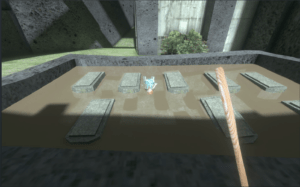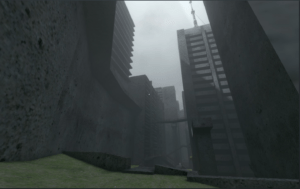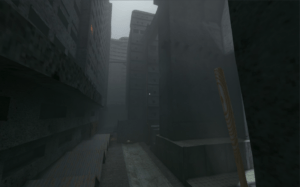A dreary, gray, dystopian city abandoned, left to rust and rot, to fade away, crumble and crack over time until it and everyone that lives there is forgotten. Except for you. In Babbdi, you play as a citizen trying to escape the decrepit city (also called Babbdi). Most games that involve escaping dystopian leaders and oppressive governments involve running and gunning, heavy action, explosions, and love and loss. Babbdi, however, strips everything away, leaving just the story and the ruins of a city.
In Babbdi, you play as an ordinary citizen trying to escape the city. No running and gunning, no love and loss, and no explosions. Actually, there’s no combat at all. Babbdi is a first person exploration game with light platforming and exploration: that’s it. And it works. Babbdi leans on exploration and forces the player to uncover information about the dystopian, gray city they’ve been planted in. Because of this, Babbdi is suitable for mature players that enjoy dystopian fiction and exploration games. It can get a little dark, so it’s certainly tailored for teens and up. It’s a little more involved than most walking simulators, since there is a lot of platforming and the game leans on creative exploration (like using a leaf blower to propel yourself up buildings, etc), so players need to have high levels of creativity.
 (dead body in a pond graveyard)
(dead body in a pond graveyard)
The game’s objective is to escape Babbdi. Once the player gets on the train leaving Babbdi, which is not too difficult to find due to clear signage, the game ends. While players can certainly speed run the game and get on the train as soon as possible, there are tons of mini objectives which make the game worthwhile and require more exploration. Mini objectives range from finding rare objects at the end of platforming puzzles, to reaching the highest point on the map. Again, all objectives rely on exploration and discovery, which is a really cool mechanic that I hadn’t seen before. Hiding required objectives behind discovery is a unique mechanic that creates a dynamic of mystery and thrill to discover new items and unlock certain achievements. It took me around 15 minutes to complete one of the jumping puzzles at the start of the game and felt super rewarding when I finally got the rare object!
These main mechanics lead to discovery and narrative being the main types of fun. While the discovery aspect isn’t all that surprising, since this is a discovery/exploration game, the fact that narrative is a main type of fun for Babbdi is, at first, puzzling. But, even though this game is “merely” a walking simulator, it tells a fantastic story between good and evil, light and darkness, represented through the dystopian city of Babbdi.
Most AAA, large video games (the ones I’m most familiar with at least) center around some conflict which is driven through characters. For example, STAR WARS: JEDI SURVIVOR just came out and centers around a Jedi trying to outrun the Empire, and this conflict is told through characters on both sides – the Jedi and the Sith. In Babbdi, there is no representation of the evil, dystopian forces. The only interaction and sense of conflict we get is with other, mysterious NPCs on the map. These NPCs are basically faceless, and only give off one or two sentences of dialog when prompted about their current situation (most of them are trying to leave Babbdi too or get into hiding). While we don’t get a ton of info from them, I think this was really well done and makes the game more mysterious and ominous, adding to narrative as a type of fun for Babbdi. These NPCs are acting like real people probably would: scared, timid, and worrisome of their dystopian leadership. So, while the evil dystopian forces are never shown, their impact is felt through this NPC mechanic. We get a sense how powerful and scary the dystopian force must be since the NPCs are acting the way they are. This slightly altered mechanic of the famous principle “show don’t tell” is brilliant for this type of game since oftentimes, when developers “show” the evil they’ve tried to hide and keep an ominous mystery, audiences are underwhelmed with its “fear factor.” For example, when filming the climactic ending battle in the final Lord of the Rings movie, Peter Jackson decided not to show Sauron, the big bad villain that had been plaguing beloved characters for the past 9 hours of the trilogy. Producers were stunned with this decision, but Jackson knew that no matter how they filmed or edited it, Sauron was going to be scarier in our heads and imaginations than he would be on screen. Thus, Sauron is not shown in the final battle. And it works!

After not thinking I’d enjoy walking simulators because I’m more into RPGs and action/adventure type games – games I thought had stronger narratives than “walking games,” I was really stunned with Babbdi’s narrative mechanics. Even though the objective is to leave the dystopian, gray city, the mechanics used by the Lemaitre Brothers make me want to stay in Babbdi for as long as I can.





